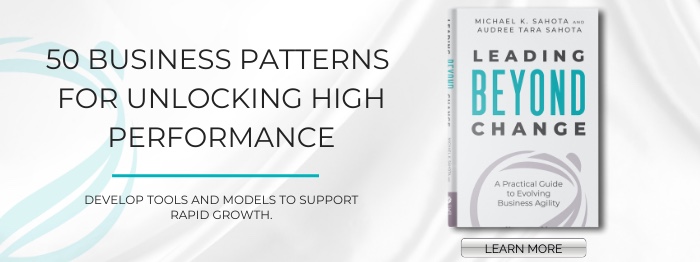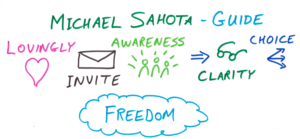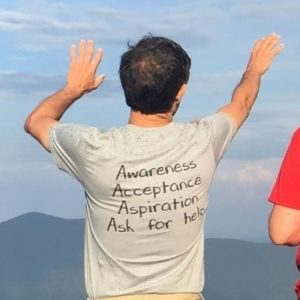Want to grow and develop quickly? The 4A’s Leadership Model is a simple and effective process for personal growth. In this post, you will learn how to use it.
Stand in the Truth – A Leadership Model Summary
One can see “Stand in the Truth” as a summary of the 4A’s leadership model. When we stand in the truth we discover what reality really is. In this process we learn about ourselves and discover a path for growth.
Why? Our minds are nothing but reality distortion devices. Our minds are designed to add, delete, distort and confabulate (that means to make up stuff) information. When we stand in the truth, we discover how the model of reality in our head is different from external reality. This process is often discomforting and can be painful since we are very attached to our model of reality. Especially our self-image.
Standing in the truth is an essential practice. When we stand in the truth, we can see to the heart of our challenges. To what is really happening. And from this place we may create lasting solutions. When we are disconnected from the truth of reality, all action and solutions will actually lead to more problems since they will fail to address what is really happening.
While “Stand in the Truth” is fantastic guidance, it is too abstract to help us know what to do. That’s where the 4A’s help us.
4A’s Leadership Model
The 4 A’s Leadership Model is very simple:
- Awareness
- Acceptance
- Aspiration
- Ask for help
Each step builds on the earlier step. Let review each one in turn.
Awareness
Awareness means that we have a conscious understanding of a particular personality edge or issue with how we show up. We may notice how our behaviour is not getting us the results we want. Or we may notice when the results are what we don’t want.
Sometimes we may get stuck on this step. Something the issue is so outside of our model of reality that we have a hard time even becoming aware of it.
Example: I am aware that I get attached to my ideas and have a hard time really listening to other people. (This is a true example. I do have an developmental edge around this. It’s better and still a work in progress at times.)
Acceptance
Acceptance means that we accept that the thing we are aware of is actually true. We fully believe it to be true. We accept the truth of the situation and are no longer resisting it. We accept how the behaviour impacts our life including those around us.
The opposite of acceptance is denial. When we are in denial, we are aware of something but we deny the truth of it. we choose to believe something else as true.

Even more dangerous is partial acceptance. We use words like, “I mostly see this, but …” Partial acceptance is not acceptance. It’s a self-deceptive version of denial. We are in denial and we lie to ourselves about this. Why? We are not ready to acknowledge we are in denial. So if you see this, simply become aware of this.
Example: I accept that I get too attached to my ideas. And the more passionate I am about the topic, the more attached I get. So really listening to people about culture and leadership can be challenging for me – it’s either a love-in or I have to struggle to really listen.
Aspiration
Aspiration is what we want for ourself. We might also call this desire. When we connect in with our heart, our gut, our highest self, we get a sense of what we want in our life. It may be the cessation of a negative behaviour or the fostering of an alternate more healthy behaviour. It is our deepest hope for ourselves. This is aspiration.
Example: I aspire to share my ideas without attachment. So that people have freedom to believe or to disagree. I aspire to listen to others fully – especially when they are sharing ways of thinking that are conflicting with my beliefs.
Ask for Help
If we control our thoughts and actions, then we simply go ahead and change the behaviour or personality edge.
If you are like me, you may have some awareness that we don’t control our thoughts and actions. So how do we approach growing and evolving? Ah! We need to approach growth and change differently.
I like to think of the human mind as a complex system. We don’t actually control it. All that we do control is our awareness. And if you have ever tried to meditate, you already know it is really hard to even control awareness. So what to do?
Our work is the first 3 A’s. To have awareness, to stay in acceptance and to be connected with our aspiration. That requires effort and attention.
The 4th A is for Ask for help. If you, like me, want to grow quickly, then the 4th A is the secret sauce.
Ask People for Help
The most common use of “Ask for help” is to ask people around us to help. Pick people you trust. People who care about you as person. Explain to them your awareness and aspiration. Then ask them to help: “Hey, when you see me doing this, will you please let me know in a kind and caring way.”
It turns out that this is very practical. Even though it is hard for us to be self-aware, it is really obvious to others when we are stuck in a personality edge. It’s obvious to them because they need to put up with our behaviour. You may notice how easy it is for you to recognize when other people are exhibiting unhelpful behaviours.
Example: I have a standing invitation with my kids, some friends and some colleagues to let me know if it looks like I am getting too attached to my ideas and not listening to others fully.
Ask the Universe for Help
This is the part where we leave the natural, scientific frame of understanding reality.
There are many ancient wisdom traditions as well as modern ones such as The Secret, hold that the universe is designed to give us what we ask for. So this is the second meaning of Ask for help – to surrender the personality edge (which is outside of our control) to the universe.
One may approach this from a spiritual practice or from a purely logical and pragmatic place. Both are lovely.
In my own personal practice, I connect in my heart centre. To my connection with the universe/creation/divine/higher sacred self. This is a feeling, not a thinking thing. Once connected, it’s can be as simple as sharing intent to surrender of the behaviour.
Example: I accept that my pattern of staying attached to my ideas is not in my control and I ask the universe to alter my unconscious mind so that I stop acting like this.
Start with Awareness
Sometimes people learn this model and are not sure where to start. They say: what should I have awareness around?
One good answer is to focus on awareness.
- Awareness: I don’t really know what edges I have that are harming my relationships.
- Acceptance: Yup. I don’t know. I get that I do something not useful since I am human and I see it in other people. So it must be in me too. I just don’t know what it is.
- Aspiration: I want to learn about my edges so I can be a better leader, parent, etc.
- Ask for help: Hey, I am working on my awareness. When I do stuff that is creating problems, will you please tell me?
Example: I asked some very good friends to let me know when there was stuff going on that I have no awareness of. I was very surprised to learn how my mind was completely deleting information. It reshaped my reality in good ways.
Example: I have noticed a pattern where all the edges I thought I had worked on in the past are all still there. Just more subtle but just as devastating in impact. So if you need to look for something, look really carefully at what you think has been “resolved”. You may be surprised.
4A’s Leadership Model – Where does it fit?
The 4A’s is a super-light-weight leadership model. It is compact and minimalistic.
Some leadership models have many dimensions of leadership, detailed surveys and reports. This is all truly wonderful stuff and can help increase awareness of our edges.
And all we can really focus on is one or two edges at a time. So just notice what edge is causing you the most problem right now and work on that. If you don’t know, just ask people around you – they will be happy to help.
History of the 4A’s Leadership Model
When I was going through the accreditation process with the Scrum Alliance for the new Certified Agile Leadership program, Peter Green asked me: “What is your leadership model?”
I first responded with what I had included in my submission – the VAST Model (Vulnerability, Authentic connection, Safety and Trust). But that didn’t feel like the full story.
I then shared other things I was doing working with leaders and organizations to help them develop. How I would invite awareness to foster growth.

This is so important, I have this on the back of my business card:
I realized that that moment that I was “Unconsciously Competent”. I was competent in leadership development but that I was unconscious of how I did it. This question triggered my reflection on how I help people grow.

The formulation of the 4A’s came together with input from two good friends, Olaf Lewitz and Marion Willeke, during a magical day in Asheville, NC in the days leading up to Agile 2016 Conference. I had all the bits and pieces, but I needed my friends to help come up with the 4A’s. We did this in a T-shirt shop in about 5 minutes. We were there to custom print the model so I could wear the T-shirt at the conference. Here are the first moments with the T-Shirts. As you can see, the first version had “The truth will set you free” instead of “Stand in the Truth”.

Where Does It Come From?
I made it up based on my own understanding of how I develop myself. When I realized a few years ago that my ability to help others is limited by how I show up, I have been very deliberately developing myself and working through edges. I have learned many things from many traditions and people.
The most significant influence is from the teachings at Oneness University in India – the place where I go to learn and grow. There I learned very deeply how to see the truth of how I am as human being. How my mind works. How reality is perceived. This is where the phrase “Stand in the truth” comes from.
Another key influence is Buddhism. The key phrase that lives in my mind is:
Suffering is caused by resisting reality.
I see standing in the truth as a way to cease resisting reality. As a way to reduce suffering. As a way to begin real and sustainable growth.

Where To Learn More?
The 4A’s is a key part of my ongoing Certified Agile Leadership Training classes. Please join me to learn more about this and other ways of growing ourselves, and our organizations. Attending a Oneness course in India or via livestream is also an excellent option.



